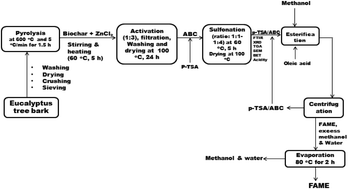Sulfonated biochar catalyst derived from eucalyptus tree shed bark: synthesis, characterization and its evaluation in oleic acid esterification
Abstract
Herein, fatty acid (oleic acid, OA) was upgraded to fatty acid methyl ester (FAME) via esterification reaction using sulfonated biochar obtained from eucalyptus tree shed bark as solid acid catalyst. Under the optimal esterification conditions (i.e., at 65 °C for 2 h using a methanol/OA molar ratio of 10 : 1 with a catalyst dosage of 4 wt%), the FAME yield was 97.05 ± 0.28% when a solid acid catalyst prepared by loading 6 g of p-Toluenesulfonic acid (p-TSA) on 2 g of activated biochar (p-TSA3/ABC) was used. The remarkable performance of the p-TSA3/ABC could be attributed to its high acidity (468.8 μmol g−1) and dominance of the SO3H acid site on the catalyst surface. Experimental findings showed that the p-TSA3/ABC was relatively stable due to its highly functionalized structure. The catalyst was recycled for five successive cycles and exhibited no dramatic decrease in catalytic activity.

- This article is part of the themed collection: Young African Researchers


 Please wait while we load your content...
Please wait while we load your content...